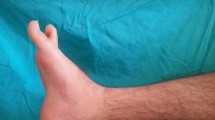Abstract
Purpose
There is however gross ambiguity regarding the use of term “foot abduction” in clubfoot treatment. We measured below defined angles at different stages of clubfoot treatment to decipher their precise interpretation.
Methods
In a prospective evaluation of 25 unilateral clubfeet in infants’ age less than six months treated with Ponseti technique, clinical leg foot and thigh foot angle were measured at talar head reduction (LHT0), pre-tenotomy, and post-tenotomy stage. A “normal” reference was available in the form of measurements of contralateral limb.
Results
Talar head (LHT0) was reduced at mean leg foot angle of 26 degrees. The corresponding pre- and post-tenotomy angles were 42.6 and 50.0 degrees, respectively. The reference leg foot angles for contralateral limb were 49.8 degrees. The thigh foot angle for LHT0, pre-tenotomy, post-tenotomy, and contralateral side were, respectively, 39.2, 56, 68, and 65.6 degrees. There was an additional tibial external rotation component of mean 13.4 degrees (SD 4.5) in the thigh foot angle when compared to the leg foot angle at tenotomy. This increased to 18 degrees (SD 3.4) post-tenotomy.
Conclusions
The study suggested that the foot abduction described in the “Ponseti Manual” probably intends thigh foot rather than leg foot angles. There was a significant difference in the angles when talar head reduced and tenotomy was decided. The foot abduction is an ambiguous term which should be replaced by the more specific leg or thigh foot abduction angle.



Similar content being viewed by others
Data availability
The raw data can be provided on reasonable request to the corresponding author.
References
Shabtai L, Specht SC, Herzenberg JE (2014) Worldwide spread of the Ponseti method for clubfoot. World J Orthop 5:585–590. https://doi.org/10.5312/wjo.v5.i5.585
Elgohary HSA, Abulsaad M (2015) Traditional and accelerated Ponseti technique: a comparative study. Eur J Orthop Surg Traumatol 25:949–953. https://doi.org/10.1007/s00590-015-1594-5
Dobbs MB, Rudzki JR, Purcell DB et al (2004) Factors predictive of outcome after use of the Ponseti method for the treatment of idiopathic clubfeet. J Bone Joint Surg Am 86:22–27. https://doi.org/10.2106/00004623-200401000-00005
Tahririan MA, Ardakani MP, Kheiri S (2021) Can clubfoot scoring systems predict the number of casts and future recurrences in patients undergoing Ponseti method? J Orthop Surg Res 16:238. https://doi.org/10.1186/s13018-021-02261-4
Barik S, Nazeer M, Mani BT (2019) Accelerated Ponseti technique: efficacy in the management of CTEV. Eur J Orthop Surg Traumatol 29:919–924. https://doi.org/10.1007/s00590-018-2353-1
Pulak S, Swamy M (2012) Treatment of idiopathic clubfoot by ponseti technique of manipulation and serial plaster casting and its critical evaluation. Ethiop J Health Sci 22:77–84
Pirani S, Staheli L, Naddumba E (2008) Ponseti clubfoot management: teaching manual for healthcare providers in Uganda, 1st edn. GHO Publications, Seattle
Lourenço AF, Morcuende JA (2007) Correction of neglected idiopathic club foot by the Ponseti method. J Bone Joint Surg Br 89-B:378–381 https://doi.org/10.1302/0301-620X.89B3.18313
Mosca V (2008) Clubfoot: biomechanics and practical principles-based application of the Ponseti method, 1st edn. Global HELP Organisation, Seattle
Gupta P, Mittal N, Jindal N et al (2017) A study of normal foot abduction across various age groups in children. Int Orthop 41:2365–2369. https://doi.org/10.1007/s00264-017-3603-2
Agarwal A, Rastogi P (2021) Dimeglio’s derotation of calcaneo pedal block and Pirani’s talar head reduction: a quantitative matching. J Pediatr Orthop B 30:467–470. https://doi.org/10.1097/BPB.0000000000000812
Dietz FR, Noonan K (2016) Treatment of clubfoot using the Ponseti method. JBJS Essent Surg Tech 6:e28 https://doi.org/10.2106/JBJS.ST.14.00112
Diméglio A, Bensahel H, Souchet P et al (1995) Classification of clubfoot. J Pediatr Orthop B 4:129–136. https://doi.org/10.1097/01202412-199504020-00002
Agarwal A, Barik S (2019) Effect of bar length on foot abduction and ankle dorsiflexion in Steenbeek foot abduction brace. J Pediatr Orthop B 28:564–571. https://doi.org/10.1097/BPB.0000000000000652
Shah A, Mehta R, Aroojis A (2019) The Ponseti method of clubfoot treatment in walking age children: is it effective? A study of 56 children from 1 to 10 years of age. J Pediatr Orthop B 28:159–166. https://doi.org/10.1097/BPB.0000000000000562
Author information
Authors and Affiliations
Contributions
All authors contributed to the study conception and design. Material preparation, data collection, and analysis were performed by Dr. Yogesh and Dr. Anil Agarwal. The first draft of the manuscript was written by Dr. Sitanshu Barik, and all authors commented on previous versions of the manuscript. All authors read and approved the final manuscript.
Corresponding author
Ethics declarations
Ethics approval
This study was performed in line with the principles of the Declaration of Helsinki. Approval was granted by the Institutional Ethics Committee of Chacha Nehru Bal Chikitsalaya (F.I/IEC/CNBC/18/01/2022/Protocol no 103/263).
Consent to participate
Written informed consent was obtained from the parents.
Consent to publish
Written informed consent was obtained from the parents.
Competing interests
The authors declare no competing interests.
Additional information
Publisher's note
Springer Nature remains neutral with regard to jurisdictional claims in published maps and institutional affiliations.
Rights and permissions
Springer Nature or its licensor (e.g. a society or other partner) holds exclusive rights to this article under a publishing agreement with the author(s) or other rightsholder(s); author self-archiving of the accepted manuscript version of this article is solely governed by the terms of such publishing agreement and applicable law.
About this article
Cite this article
Patel, Y., Barik, S. & Agarwal, A. What exactly is “foot abduction” during management of idiopathic clubfoot in clinical practice?. International Orthopaedics (SICOT) 47, 1109–1114 (2023). https://doi.org/10.1007/s00264-023-05703-2
Received:
Accepted:
Published:
Issue Date:
DOI: https://doi.org/10.1007/s00264-023-05703-2




